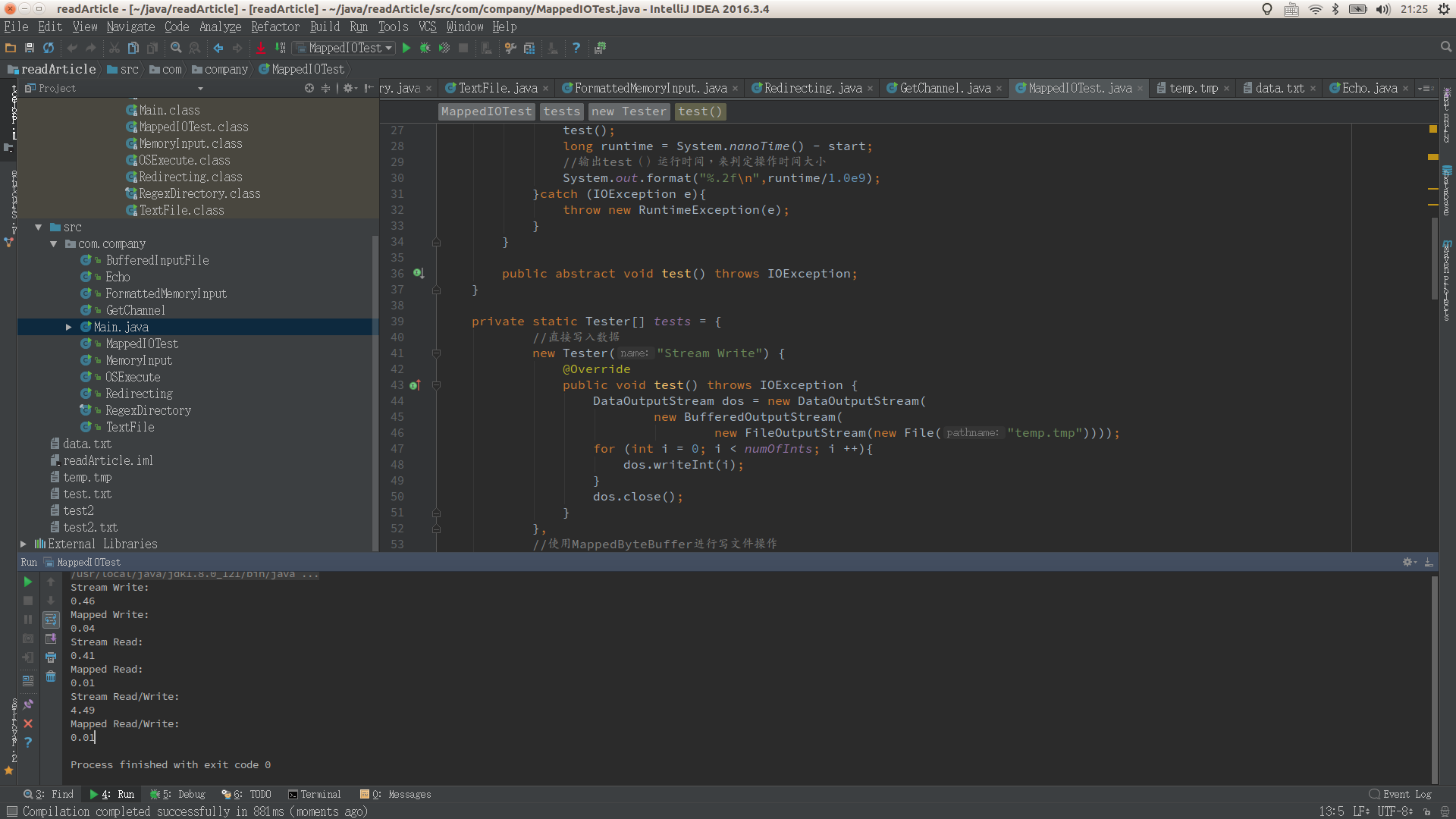Processing files is a common operation in java, and a little bit of speed improvement in operating a "large file" (for example, more than 64M) will bring about a huge performance improvement. However, we often use BufferxStream to deal with large files directly, often unable to do so.
The "Mapping File Access" mechanism in java solves this problem. It puts the smaller part of the large file in memory first and the rest of the data to be read in the hard disk. But we can use this large file as a very large array through such a mechanism. Is it very similar to how applications are used in operating systems? Yes, in fact, java uses the file mapping tools of the underlying operating system to maximize performance.
In order to be both readable and writable, we use Random Access File to test, pass through the same channel on the file, and then call MappedByteBuffer generated by map() in FileChannel. In the map method, there are three parameters map (FileChannel. MapMode, long position, long size).
Where mode determines the read/write mechanism for mapped file access, it can be set MapMode.READ_ONLY, MapMode.READ_WRITE,MapMode.PRIVATE They can be seen by their names, with special attention to MapMode.PRIVATE Method, how do you operate improperly will cause the files you operate can not be shared.
The position must be a non-negative number to begin with the location of the file mapping in the region
Size is a mapping for the size of the region; it must be a non-negative number, not greater than Integer.MAX_VALUE
In fact, the setting of position and size means that we map the smaller part of a large file.
Now let's look at the performance improvement when we use Mapped File Access.
The following is the code section:
1 package com.company; 2 3 import java.io.*; 4 import java.nio.IntBuffer; 5 import java.nio.channels.FileChannel; 6 7 /** 8 * Created by chunmiao on 17-3-15. 9 */ 10 public class MappedIOTest { 11 //Number of input values 12 private static int numOfInts = 4000000; 13 //Test the number of read and write values 14 private static int numOfUbuffInts = 200000; 15 16 private abstract static class Tester{ 17 private String name; 18 public Tester(String name){ 19 this.name = name; 20 } 21 22 //Test timing 23 public void runTest(){ 24 System.out.println(name + ": "); 25 try { 26 long start = System.nanoTime(); 27 test(); 28 long runtime = System.nanoTime() - start; 29 //output test()Running time to determine the size of operation time 30 System.out.format("%.2f\n",runtime/1.0e9); 31 }catch (IOException e){ 32 throw new RuntimeException(e); 33 } 34 } 35 36 public abstract void test() throws IOException; 37 } 38 39 private static Tester[] tests = { 40 //Write data directly 41 new Tester("Stream Write") { 42 @Override 43 public void test() throws IOException { 44 DataOutputStream dos = new DataOutputStream( 45 new BufferedOutputStream( 46 new FileOutputStream(new File("temp.tmp")))); 47 for (int i = 0; i < numOfInts; i ++){ 48 dos.writeInt(i); 49 } 50 dos.close(); 51 } 52 }, 53 //Use MappedByteBuffer Write files 54 new Tester("Mapped Write") { 55 @Override 56 public void test() throws IOException { 57 FileChannel fc = new RandomAccessFile("temp.tmp","rw").getChannel(); 58 //fc.size()The return is byte The number of units. 59 IntBuffer ib = fc.map(FileChannel.MapMode.READ_WRITE,0,fc.size()).asIntBuffer(); 60 for(int i =0 ; i < numOfInts ; i ++){ 61 try { 62 ib.put(i); 63 }catch (Exception e){ 64 System.out.println(i); 65 } 66 } 67 fc.close(); 68 } 69 }, 70 //Direct reading of data 71 new Tester("Stream Read") { 72 @Override 73 public void test() throws IOException { 74 DataInputStream dis = new DataInputStream( 75 new BufferedInputStream(new FileInputStream("temp.tmp"))); 76 for (int i = 0 ; i < numOfInts ; i ++){ 77 dis.readInt(); 78 } 79 dis.close(); 80 } 81 }, 82 //Use MappedByteBuffer Read files 83 new Tester("Mapped Read") { 84 @Override 85 public void test() throws IOException { 86 FileChannel fc = new FileInputStream(new File("temp.tmp")).getChannel(); 87 IntBuffer ib = fc.map(FileChannel.MapMode.READ_ONLY,0,fc.size()).asIntBuffer(); 88 while (ib.hasRemaining()){ 89 ib.get(); 90 } 91 fc.close(); 92 } 93 }, 94 //Read directly/Write operation 95 new Tester("Stream Read/Write") { 96 @Override 97 public void test() throws IOException { 98 RandomAccessFile raf = new RandomAccessFile(new File("temp.tmp"),"rw"); 99 //Misalignment of data for simultaneous reading and writing 100 raf.writeInt(1); 101 for (int i = 0 ; i < numOfUbuffInts ; i ++){ 102 //The reason for the reduction of 4 is raf.length()Return to byte For unit space size, and 1( int) = 4 (byte),So we need to subtract 4 103 raf.seek(raf.length() - 4); 104 raf.writeInt(raf.readInt()); 105 } 106 raf.close(); 107 } 108 }, 109 //Use MappedByteBuffer Read/Write operation 110 new Tester("Mapped Read/Write") { 111 @Override 112 public void test() throws IOException { 113 FileChannel fc = new RandomAccessFile(new File("temp.tmp"),"rw").getChannel(); 114 IntBuffer ib = fc.map(FileChannel.MapMode.READ_WRITE,0,fc.size()).asIntBuffer(); 115 ib.put(0); 116 for (int i = 1 ; i < numOfUbuffInts ; i ++){ 117 //Misalignment of data for simultaneous reading and writing 118 ib.put(ib.get(i - 1)); 119 } 120 fc.close(); 121 } 122 } 123 }; 124 125 public static void main(String[] args) { 126 //Testing 127 for (Tester tester : tests){ 128 tester.runTest(); 129 } 130 } 131 }
The following are the results of the operation:
